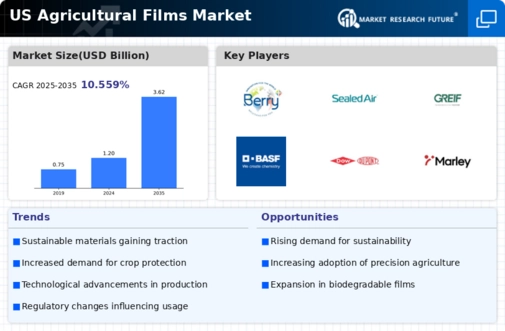The US Agricultural Films Market has been experiencing substantial growth owing to increased agricultural activities, technological advancements, and demand for efficient farming practices. Within this market, competitive dynamics are influenced by several key players, each contributing unique innovations and strategies aimed at maximizing crop yield and sustainability. As the agricultural sector increasingly prioritizes environmentally friendly solutions, companies are adapting their offerings to meet these market demands while enhancing their operational efficiencies.
Through the incorporation of advanced materials and production techniques, players in the agricultural films sector are continuously improving their products, allowing for better performance against pests, weather conditions, and soil quality. Analyzing the competitive landscape reveals insights into the strategic maneuverings of these companies, highlighting their positioning, technological prowess, and responsiveness to market trends.Berry Global has established a significant presence in the US Agricultural Films Market, primarily known for its robust portfolio of agricultural films that cater to a variety of farming needs.
The company's strengths lie in its commitment to innovation and sustainability, as well as its strong distribution network and customer relationships. By investing in research and development, Berry Global continually seeks to enhance its products, such as biodegradable and mulch films, which offer advantages in terms of crop protection and soil health. Additionally, the company benefits from economies of scale, which allows it to maintain competitive pricing while delivering high-quality films tailored for diverse agricultural applications.
This combination of innovation, sustainability focus, and operational efficiency positions Berry Global favorably within the US market landscape.Sealed Air is another key player in the US Agricultural Films Market, recognized for its expertise in providing packaging solutions that extend beyond conventional agricultural films. The company's offerings include advanced protective film products designed to enhance crop quality and minimize spoilage during transportation and storage. Sealed Air has a strong market presence bolstered by its focus on innovation, driving the development of new products tailored to the specific needs of American farmers.
Noteworthy strengths include its commitment to sustainability through the introduction of eco-friendly materials and its strategic partnerships that enhance its market reach. Sealed Air has also embraced mergers and acquisitions to expand its product range and capabilities, solidifying its position within the agricultural films sector in the US. This comprehensive approach of integrating advanced technology with sustainable practices has allowed Sealed Air to carve out a competitive niche, supporting agricultural efficiency and resilience in the face of evolving market demands.





















Leave a Comment